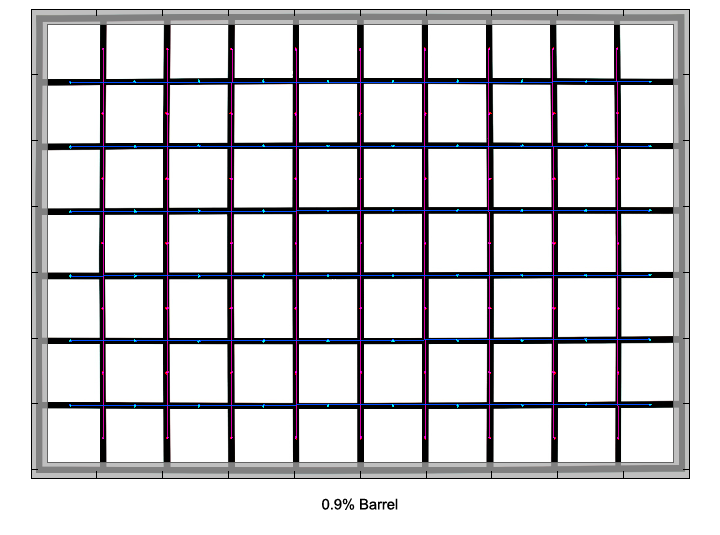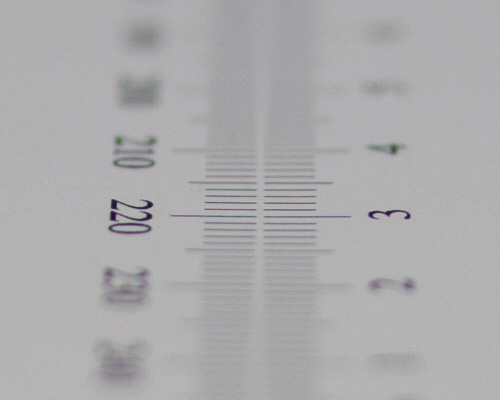|
Sigma AF 35mm f/1.4 HSM DG | A ("Art") - Review / Test Report - Analysis |
|
Lens Reviews -
Canon EOS (Full Format)
|
|
Page 2 of 3

Distortion
The lens shows a small amount of less than 1% barrel distortion, which is above average in this class.

Vignetting
Very fast lenses usually suffer from pronounced vignetting at large apertures, and the Sigma is no exception to this rule. Wide open, there is a hefty amount of light fall-off (2.65EV) towards the borders. As usual, stopping down reduces the amount of vignetting considerably. At f/2.8, vignetting is already down to very moderate levels and from f/4 onward it should no longer be an issue for most subjects.

MTF (resolution)
The lens delivers impressive resolution in our lab test. In the image center, the results are nothing short of outstanding even at f/1.4 the largest aperture. It is safe to state that the lens easily outperforms the 20 megapixel sensor of the camera used for testing. At f/11 (and beyond), diffraction limits the maximum resolution again.
The borders and corners on a good to very good level at large apertures. The quality peaks at f/4 with a quality scratching at our excellent mark. Beyond diffraction takes its toll again but the quality remains very good at least till f/11.
It is worth mentioning that the lens showed no focus shift when stopping down (residual spherical aberration).
Please note that the MTF results are not directly comparable across the different systems!
Below is a simplified summary of the formal findings. The chart shows line widths per picture height (LW/PH) which can be taken as a measure for sharpness.
If you want to know more about the MTF50 figures you may check out the corresponding Imatest Explanations

Chromatic Aberrations (CAs)
Chromatic aberrations (color shadows at harsh contrast transitions) are very well controlled showing readings below an average pixel width of 0.5px at the image borders.

Bokeh
One of the primary usage scenarios for a large aperture lens is to seperate the main subject from the background. In such an image the quality of the bokeh (out-of-focus blur) is of major significance.
The lens generally delivers quite smooth bokeh for a wide angle prime but it is not perfect here. In our test scene below the Sigma shows a tad of nervousness in the focus transition zones - more so towards the more critical background.
 Thanks to 9 rounded aperture blades, background highlights retain their circular shape in the relevant aperture range, except towards the image corners, where they are cut off a little at one side due to mechanical vignetting. There is almost no outlining in the disks formed by highlights, but the discs show a slight onion-like substructure.
Thanks to 9 rounded aperture blades, background highlights retain their circular shape in the relevant aperture range, except towards the image corners, where they are cut off a little at one side due to mechanical vignetting. There is almost no outlining in the disks formed by highlights, but the discs show a slight onion-like substructure.

Bokeh Fringing / Longitudinal Chromatic Aberrations (LoCA)
LoCAs (non-coinciding focal planes of the various colors) are a common issue with relatively fast glass. As you can notice below the halos have different colors - magenta (red + blue) in front of the focus point and green beyond. Truly "apochromatic" lenses don't show LoCAs but these lenses are very rare especially below 100mm. Unlike lateral CAs, LoCAs cannot easily be fixed in post processing.
Typical for most fast primes, especially ultra fast ones, the Sigma shows some amount of bokeh fringing at large aperture settings, which can of course be reduced by stopping down. The issue is mostly gone from f/2.8 onward.
In addition, these shots also illustrate that there is no focus shift when stopping down, as it was already mentioned in the MTF section.
|
Move the mouse cursor over the f-stop marks below to observe the respective LoCAs
|
| f/1.4 |
f/2 |
f/2.8 |
f/4 |
|

|
|